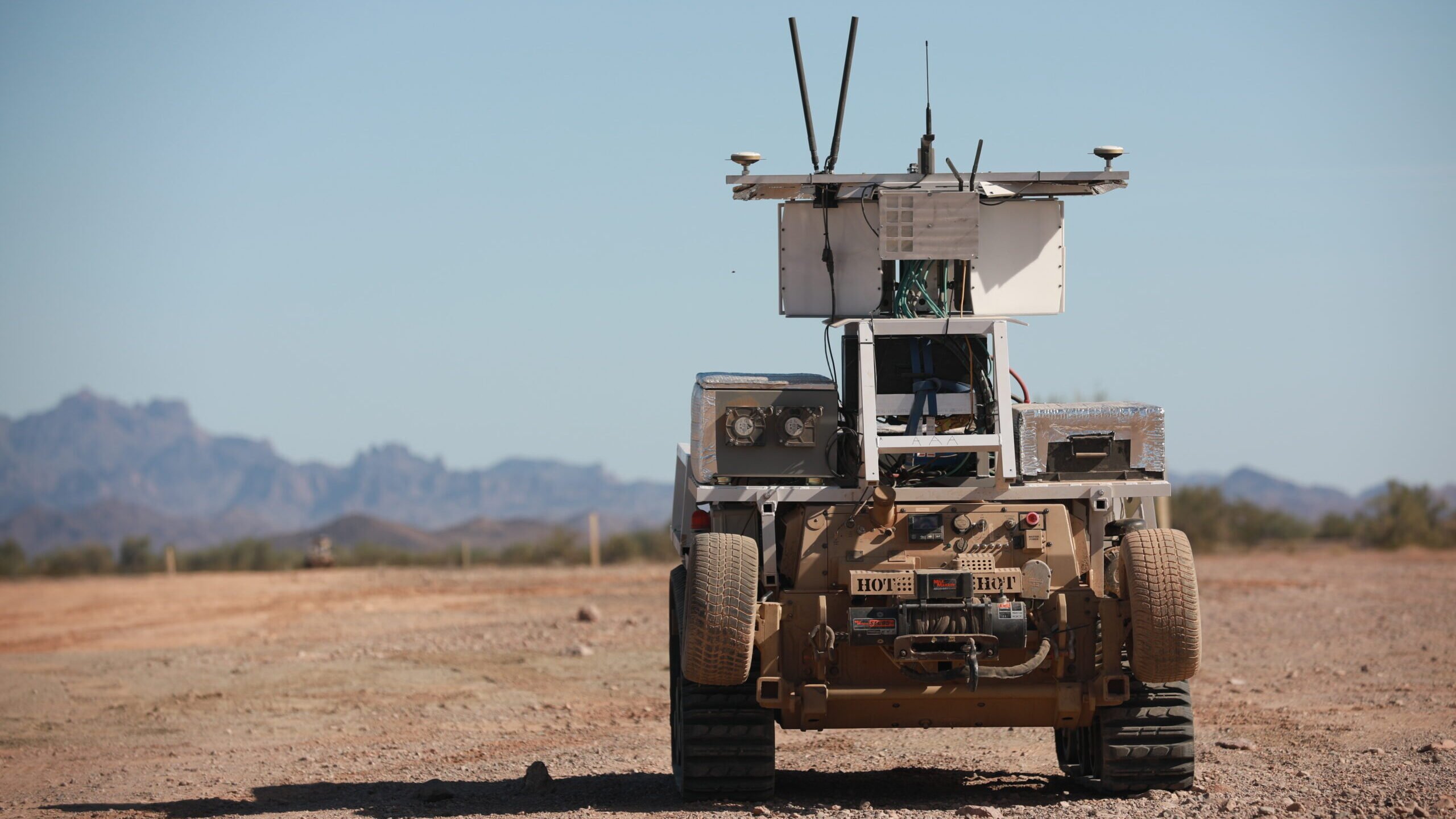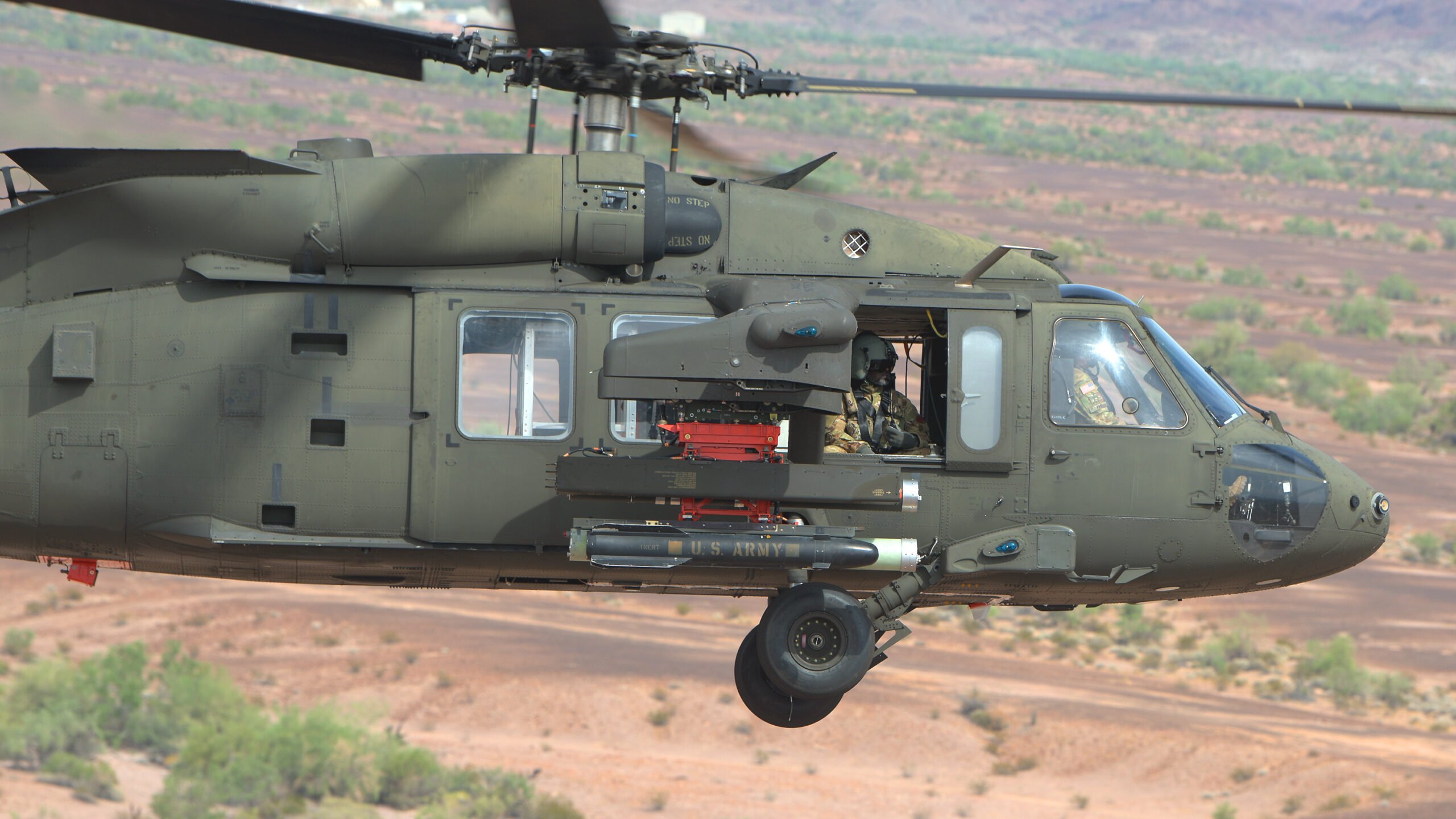ANDREW EVERSDEN

YUMA PROVING GROUND, Ariz.: Four small quadcopters equipped with ISR gear search the battlefield for the enemy. On the ground, four robotic combat vehicles drive across the terrain doing the same. During the mission, the pair are communicating and coordinating the unmanned recon mission.
“It’s this idea of collaborative sensing,” said Col. Andre’ Abadie, co-lead for the Project Convergence 2021 operational planning team. “It’s one thing to have one sensor do aided target recognition and say, ‘I see an enemy tank.’ It’s another thing when a sensor can say ‘I see an enemy tank. Hey, guy from the air, tell me, is that a tank? Hey, other guy from another angle tell me is that a tank?’”
On the future battlefield, the Army plans to use combinations of autonomous platforms from future land vehicles to high-endurance drones to provide situational awareness and to undertake missions often perilous to soldiers, including target identification, reconnaissance and resupply — hopefully talking together the whole time. The new methods were tested in seven broad scenarios at Project Convergence, the Army’s annual sensor to shooter experiment, meant to recreate specific challenges in future, complicated joint warfighting.
“The common perception is that robots remove a human from the battlefield and take them out of harm’s way potentially,” said Lt. Col. David Olsen, operations officer for the Next-Generation Combat Vehicle Cross-Functional Team, during a media day earlier this month. “We look at an additional aspect of that is that a robot can bring more capability to the battlefield that a soldier can put on their back, or that we can necessarily mount on every single vehicle.”
At the exercise the Army also experimented with targeting and engaging targets using its Firestorm technology, which ingests battlefield data passed from ISR platforms and recommends to human operators which weapon system should take a shot. PC21 this year involved more platforms and increased its focus on linking them together, Olsen said.
“Last year, we had more so individual platforms that were sensing and engaging targets,” Olsen said. “Now we’re sharing it across that whole formation.”
For autonomous land vehicles, PC21 pushed them in a new direction: off road. Last year, Abadie said the service gave autonomous vehicles waypoints to drive. This year, vehicles were told what their area of reconnaissance was and were left to operate on their own.
“Those robotic vehicles and their ability to collaboratively sense decided how to recon that area on their own, and then decided how to report back those threats to the C2 [command and control] node,” Abadie said.
That’s a significant development, Olsen said, because it “reduces the task load on the soldiers and puts it on those autonomous systems to increase our capability overall.” Next year, the Army wants to test those capabilities at night, Abadie said.
However, the Army is still contending with a unique challenge not seen in the civilian world of self-driving cars. Some self-driving cars can use LiDAR, a type of radar sensing, to see stop signs, pedestrians or street lights. The Army can’t because LiDAR can easily be detected on the battlefield.
“It lights me up like a Christmas tree. I’ll die soon,” Abadie said. “So we have to use alternative ways of sensing the terrain. And so it is truly a hard problem to do off-road autonomous navigation.”
Surrogates for future ground vehicles were included in a third scenario simulated an AI-enabled ground attack. Olsen said that surrogates for future tanks paired with UAS systems and dismounted soldiers to make targeting decisions.
During that scenario, Olsen said, dismounted soldiers identified an enemy vehicle using a small drone and determined they would be unable to defeat it using their own systems. Using the network, soldiers passed the location of the enemy tank to a friendly tank to engage.
The scenario was a “great demonstration of the flexibility that these linkages that that network provides us,” Olsen said.
Progress For An Autonomous Helicopter
Soldiers are pinned down and surrounded by the enemy. They are running out of supplies, and any manned resupply mission would be perilous.
But in an Arizona desert earlier this month, the Army showed that the resupply could be done without putting any more troops in harm’s way by instead using remote-controlled full-sized choppers like a UH-60 Black Hawk.
“This is a hugely powerful capability,” said Stuart Young, program manager at DARPA, at an October media day for Project Convergence 2021. The Black Hawk resupply experiment was done as part of DARPA’s advanced autonomous flight program, called the Aircrew Labor In-Cockpit Automation System.

A manned UH-60 flies at Project Convergence 21. In the future, the helicopter could fly unmanned for missions such as resupply. (Courtesy of FVL CFT)
The ALIAS program successfully completed an autonomous resupply mission at Project Convergence, though with safety pilots on board. The demonstration at Project Convergence could prove useful for the Future Vertical Lift Cross-Functional Team as it develops two new future helicopters: the Future Attack Reconnaissance Aircraft and the Future Long-Range Assault Aircraft. Both will have a need for some degree of autonomy.
The ALIAS provides an opportunity for the service to “learn a lot about autonomy and what specific requirements the Army would want,” Young said.
The ALIAS program could benefit the service more broadly as it thinks about the future of its Black Hawk fleet.
“We can add autonomy to our enduring fleet,” Young said. “So think about all of those Black Hawks that we have in our enduring fleet right now. We have the opportunity to increase their mission endurance and duration of time, and the flexibility of mission sets that [the Army] can do with them.”
At the Future Vertical Lift media day at Project Convergence held Oct. 26, Breaking Defense saw in-person the first autonomous launch of an Air-Launched Effect-Small, or a small drone, that carried ISR capabilities. In January, the ALIAS program will complete its first fully autonomous flight without safety pilots.
It’s a crucial capability that could save lives on dangerous missions in the future, but it’s usefulness extends beyond that, according to Maj. Gen. Walter Rugen, director of the future vertical lift cross-functional team. It could also serve as a massive boon to Army logistics.
“On the logistics front, when you look at what ALIAS is doing [with] the absolute cargo carrying capacity of the Black Hawk and the range, I haven’t seen a UAS meet that yet,” Rugen said. “Somebody is gonna have to come up with a pretty compelling UAS that’s vertical lift that can carry that amount and do it at that range and so I’m excited about that, too.”
No comments:
Post a Comment